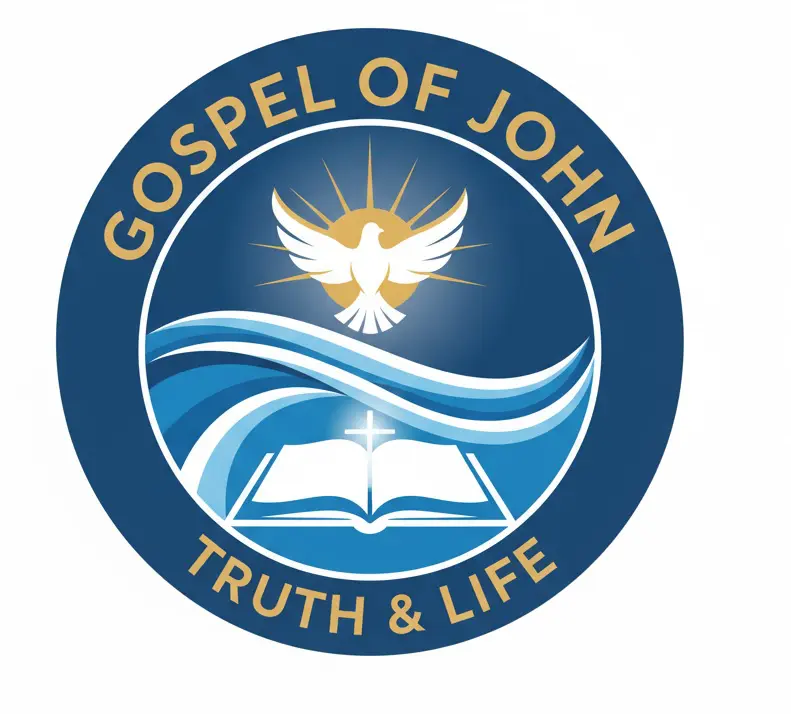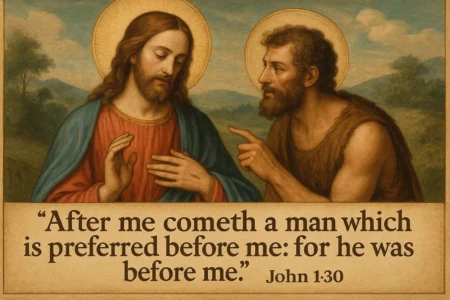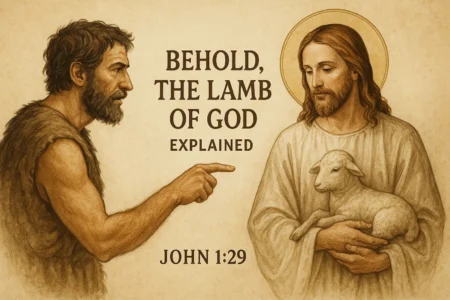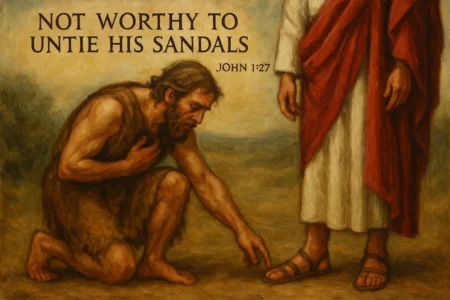We’ve all done it. You’re reading a Bible passage you’ve heard a thousand times. Your eyes just skim the words. Bethany. Capernaum. Galilee. They’re just stage-setting, right? Background noise. But then, one day, a word just… stops you. Dead in your tracks.
For me, that word is in John 1:28. “These things were done in Bethany beyond the Jordan, where John was baptizing.”
Hold up. Bethany?
Wait a minute. Bethany is where Mary, Martha, and Lazarus lived. That’s a little town just over the hill from Jerusalem. What in the world is it doing ‘beyond the Jordan’? That single, tiny question pulls a thread that unravels a massive historical and spiritual mystery. Chasing down the John 1:28 meaning isn’t just a geography lesson. It’s about realizing the spot Jesus chose for his baptism was a sermon before he ever spoke a word.
I remember exactly when this hit me. I wasn’t in a church pew. I was at my desk, years ago, with a map of the Holy Land spread out, trying to plan a trip. Bethany on the Mount of Olives? Check. Easy. But I stared at that map until my eyes blurred, and I could not find a second Bethany on the other side of the Jordan River. It sent me down a rabbit hole of commentaries, ancient maps, and archaeological digs. And what I found was that this “other Bethany” is the whole key. It’s the X on the map. It’s the launchpad for Jesus’s entire public ministry. It’s a hinge on which all of history turned.
So, let’s go find it. Let’s figure out what this all means.
More in John Chapter 1 Category
Key Takeaways
Before we dive in, here’s the quick-and-dirty version:
- John Knew What He Was Doing: John wasn’t just being sloppy with names. He meant to say “Bethany beyond the Jordan.” He was an eyewitness, and he was deliberately separating this spot from the other, more famous Bethany.
- That “Bethabara” Name: Your King James Bible might say “Bethabara.” That’s an ancient mix-up. A super-smart scholar in the 3rd century, Origen, was just as confused as we are. He couldn’t find a “Bethany” on the east bank, so he guessed the text was wrong and “fixed” it. But the oldest manuscripts we have? They all say “Bethany.”
- “Beyond the Jordan” = East Bank: This phrase is simple. It means the eastern side of the river, in the modern-day country of Jordan.
- We’ve Probably Found It: There’s an archaeological site in Jordan called Al-Maghtas (or Tell el-Kharrar). It’s the top candidate, and folks like UNESCO agree this is the place.
- It’s All About the Why: This isn’t just geography. It’s theology. This same area is where the prophet Elijah was taken to heaven. Jesus starting his ministry right here is a massive statement. It’s like saying, “The sequel starts now.”
What’s in a Name? The “Bethany” vs. “Bethabara” Puzzle
It’s a weird feeling, right? You open two Bibles, look up the same verse, and they just… have different words. It’s jarring. That’s exactly what happens here. The old King James says: “These things were done in Bethabara beyond Jordan…” But your NIV or ESV says: “This all happened at Bethany on the other side of the Jordan…”
So… which is it? And does it really matter?
Yes, it matters a lot. The story here is a fascinating bit of historical detective work. For centuries, “Bethabara” was the name everyone used. The reason? One guy: Origen. This 3rd-century scholar was a total rockstar of biblical study. But when he studied John 1:28, he hit the same wall I did. He knew Bethany near Jerusalem. He couldn’t find any record of a second Bethany on the east bank.
This bugged him. A lot. So, he came up with a theory: the original text must have a typo. He proposed the real name should be “Bethabara,” which means “House of the Ford.” You have to admit, it makes sense. A major river crossing seems like the perfect place for a public ministry. His idea was so good that it stuck, got copied by scribes, and eventually landed in the King James Bible.
So, Why Did We Go Back to “Bethany”?
What changed? Archaeology. We started finding manuscripts that were way older than anything Origen had to work with. And a clear pattern emerged. The oldest and most reliable texts—the heavy hitters like the Codex Sinaiticus and Codex Vaticanus—all say “Bethany.” The evidence is overwhelming. “Bethany” is what John wrote.
It just looks like Origen, for all his genius, was trying to fix a problem that wasn’t really a problem. He was just looking for a town that, by his day, had probably been dust for a century.
And this is important, because the name “Bethany” has its own power. It likely means “House of the Poor” or “House of Affliction.” Think about that. Jesus doesn’t kick off his ministry in the glorious Temple or a fancy palace. He launches it from the “House of the Poor,” out in the middle of nowhere, surrounded by people owning up to their sins. Getting that name right brings back a powerful, quiet detail.
Why Does John Even Bother Naming the Place?
Okay, so the word was “Bethany.” But that just makes the original question sharper. Why does John name the spot when Matthew, Mark, and Luke don’t? They’re all fine with just “the Jordan River.” Why does John add this one, tiny, specific detail?
This, I think, is the key to John’s whole book. His Gospel is full of these little “I-was-there” details. He tells you it was “about the tenth hour” (John 1:39). He tells you there were “six stone water jars” (John 2:6). He tells you the servant who got his ear lopped off was named “Malchus” (John 18:10).
This isn’t just color. This is John slamming his fist on the table. He’s yelling, I was there. I saw it. This isn’t a myth. This is history.
When he writes “Bethany beyond the Jordan,” he’s doing the same thing. He’s dropping a pin on a real map. He’s grounding this world-changing event in physical, gritty reality. He’s drawing a line in the sand between “once upon a time” and “it happened right here.”
Isn’t This Just Confusing?
You might still be thinking, “But John, that’s just confusing! You knew everyone would think of the other Bethany!”
You bet he did.
That’s the whole point. The confusion is the feature. He wants you to stop and go, “Wait… what?” By adding that little phrase, “beyond the Jordan,” he’s practically shouting, This is NOT the Bethany you’re thinking of.
Think about it. The other Bethany, the one near Jerusalem, is the home of his friends. It’s a place of comfort, family, and domestic life. It’s where he raised Lazarus, his biggest miracle before his own resurrection (John 11). It’s “inside” the system, a short walk from the center of Jewish power.
This new place is the total opposite. It’s wild. It’s the frontier. It’s outside of everything. It’s a place for repentance, for starting over. John is drawing a stark contrast. The new thing God is doing isn’t starting in the capital. It’s starting way out here. In the wilderness. At the “House of the Poor.”
The Geographical Hunt: What Clues Do We Have?
Alright, let’s put on the detective hat. We need a place called “Bethany” on the east bank of the Jordan. What else do we know?
The text gives us two massive clues. First, the name: “Bethany Beyond the Jordan.” From John’s point of view in Judea, “beyond” means the east bank. Simple. That puts us in the modern-day Kingdom of Jordan.
Second, its purpose: “where John was baptizing.” This is the real giveaway. As a guy who’s done his share of hiking and camping, you learn Rule #1 fast: you make camp near water and near a trail. John the Baptist was doing the same thing, just on a massive scale. He couldn’t just set up shop in some random patch of desert. He needed water (for baptizing) and a place people could actually find (a major trail or river ford).
So, we’re looking for a spot on the east bank, near a major ford, with good water. The Bible adds even more:
- It’s “in the Wilderness.” Mark 1:4 says John was in the wilderness. The Jordan Valley is exactly that. It’s rugged, dry, and empty.
- It’s near Jericho. The biggest, most famous, and most logical ford of the lower Jordan was directly east of Jericho. This was the main highway.
- Jesus used it as a safe house. Later, in John 10:40, when the heat is on in Jerusalem, Jesus “went away again beyond the Jordan to the place where John had been baptizing…” It was a known spot. A safe spot. Outside the jurisdiction of the guys who wanted him dead.
Does the Madaba Map Give Us a Hint?
For a long, long time, these clues were all we had. The trail was cold for over 1,500 years. Then, in 1884, everything changed. In the town of Madaba, Jordan, workers were clearing the floor of an old 6th-century Byzantine church. What they found was a map.
Not just any map. A massive, mind-blowingly detailed mosaic map of the entire Holy Land. We call it the Madaba Map, and it’s one of the most incredible pieces of biblical geography ever found. It’s like finding a 1,500-year-old Google Maps, made by the people who lived there.
And what does it show? Right on the east bank, exactly where we’re looking, across from Jericho, it shows a special place. There’s a church. A spring. And a Greek inscription. The inscription says, “Bethabara, the Holy (place) of the Baptism.”
This was a bombshell.
First, it proved that by the 500s AD, Origen’s “Bethabara” name had totally taken over. But more importantly, it showed that the early Christians knew exactly where they believed this happened. It wasn’t a guess. They had a specific spot, they built churches on it, and they marked it on their master map.
The Madaba Map basically hands us a bullseye. It screams, “Look here!”
Have Archaeologists Found a “Smoking Gun”?
The map gave us the “where.” The problem? For most of the 20th century, that exact spot was a militarized border zone. Closed. Full of landmines. The case went cold again. It wasn’t until the 1994 peace treaty between Jordan and Israel that archaeologists could finally get on the ground.
And what they found was breathtaking.
The site, known today as Tell el-Kharrar, was a perfect match. It’s on the east bank. It’s near the Jericho ford. And—this is the clincher—it’s not built right on the riverbank, which floods and changes course. It’s built around a set of natural freshwater springs that flow down to the Jordan. This gave John a stable, clean, and safe place to baptize, even if the river itself was a muddy mess.
Today, this site is called “Al-Maghtas,” which is just Arabic for “The Baptism.” In 2015, UNESCO declared it a World Heritage Site, identifying it as the location of “Bethany beyond the Jordan.”
What Did They Actually Find at Al-Maghtas?
The “smoking gun” isn’t one thing. It’s the whole complex. The digs uncovered an unbroken chain of belief going right back to the beginning. Here’s what they found:
- One of the World’s Oldest Churches: They found what they believe is a 3rd-century Christian prayer hall. That’s insanely early. It’s a simple building, but it means that within a couple hundred years of Jesus, believers were already worshiping right here.
- A Worship Hotspot: They didn’t just find one church. They found the ruins of at least five large Byzantine churches from the 5th and 6th centuries, all part of a big monastery. You don’t build five churches in the middle of nowhere unless the spot is sacred.
- Baptismal Pools: The site has large, cross-shaped pools with steps leading down, all fed by the springs. These were clearly custom-built for baptism rituals.
- “Elijah’s Hill”: The site is centered on a little hill that local tradition has always called “Elijah’s Hill.” This is the final clue. This is the one that ties it all together.
Is Everyone Convinced Al-Maghtas Is the Spot?
So, is the case 100% closed? In archaeology, nothing is ever 100%. There’s another site on the west bank, Qasr el-Yahud, that also has a long tradition. It’s right across the river from Al-Maghtas.
But John’s text is just so specific: “Bethany beyond the Jordan.” That phrase points hard, and really, only, to the east bank. The most likely story is that baptisms happened all over that ford, but the main settlement, the headquarters, the place John called “Bethany,” was the complex at Al-Maghtas. The evidence there is just older, deeper, and fits all the clues.
Beyond Geography: What Is the Spiritual John 1:28 Meaning?
So, we found it. We’ve pinpointed the map. But if we stop here, we’ve missed the entire point. John didn’t add this detail for a trivia night. The real John 1:28 meaning isn’t about the map. It’s about the message. The geography is the theology.
Why this place? What’s so special about this patch of wilderness?
To get that, you have to put down the New Testament and pick up the Old. The Jordan River is more than just water. It’s the ultimate symbol. It’s the line between the wilderness and the Promised Land. Crossing the Jordan means leaving the old behind and stepping into the new.
And one specific event, in this exact area, would have been blazing in the mind of every 1st-century Jew.
Are We Standing in Elijah’s Footsteps?
Remember the story from 2 Kings 2? It’s the prophet Elijah’s last day on earth. He and his apprentice, Elisha, walk from Jericho down to the Jordan. Elijah hits the water with his cloak, the river parts, and they “crossed over on dry ground.”
Where are they? “Beyond the Jordan.” In this exact same neighborhood.
And what happens next? A chariot of fire comes down, and “Elijah went up by a whirlwind into heaven.” Elisha picks up the cloak his master dropped, hits the water, and crosses back, now carrying a “double portion” of Elijah’s spirit to start his own ministry.
This is the spot. This is the hand-off. This is where Israel’s greatest prophet left, and where his successor was commissioned.
Why Is John the Baptist Acting as a New Elijah?
Now, fast-forward to John the Baptist. How is he described? “A garment of camel’s hair and a leather belt around his waist” (Matthew 3:4). That’s not a fashion statement. It’s the exact uniform of the prophet Elijah (2 Kings 1:8). John is dressing the part. He’s intentionally and publicly living out the prophecy from Malachi: “Behold, I will send you Elijah the prophet…”
So, where does this New Elijah set up his ministry? Not the Temple. He goes to the exact spot where the first Elijah left.
He is, quite literally, standing at Elijah’s bus stop, telling everyone the next bus is about to arrive.
What Does This Location Mean for Jesus’s Ministry?
And now, the final scene. Jesus comes from Galilee. He walks right up to the New Elijah (John) in the very place of the old Elijah.
This isn’t a baptism of repentance for Jesus. He has no sin. This is something different. This is a commissioning. This is an anointing. This is a coronation.
When Jesus goes into that water, he is publicly stepping into the role of the New Elisha. He is the successor. He is the one who will truly complete the work. And when he comes up, the heavens tear open, the Spirit comes down, and the Father’s voice thunders, “This is my beloved Son.”
The hand-off is complete. The new “Elisha” has just received his “double portion”—in fact, the full and infinite measure of the Spirit.
That is the John 1:28 meaning. It’s a declaration that Jesus’s ministry starts exactly where Elijah’s ended. He is picking up the mantle, not just of Elijah, but of all prophecy. He is the one everyone has been waiting for.
On top of that, he’s launching his work by re-enacting Israel’s ultimate “new beginning” story: crossing the Jordan River. Just like Joshua crossed the Jordan to start his mission in the Promised Land, Jesus is now starting his mission. He begins not from the center of power in Jerusalem, but from the edge. From the wilderness. From the “House of the Poor.”
That tiny geographical note in John 1:28 isn’t small at all. It’s a massive announcement. It’s telling us the long-awaited “day of the LORD” is here. The New Elijah has done his job. And the true King, the Son of God, has just been commissioned… right at the spot where heaven had touched earth before. The story is starting over. And this time, it’s for keeps.
FAQ
Why does John the Baptist specify ‘beyond the Jordan’ when naming the place of his ministry?
John specifies ‘beyond the Jordan’ to distinguish this location from the more familiar Bethany near Jerusalem, emphasizing its spiritual and geographical significance as a frontier for new ministry and a symbol of crossing into the new covenant.
What archaeological evidence supports the identification of Bethany beyond the Jordan?
Excavations at the site known as Al-Maghtas, now a UNESCO World Heritage Site, have uncovered ancient Christian churches, baptismal pools, and a historical connection to the biblical site, strongly supporting its identification as Bethany beyond the Jordan.
How does the location of Bethany beyond the Jordan relate to Old Testament stories, particularly Elijah’s crossing of the Jordan?
The location is the same area where Elijah crossed the Jordan River in 2 Kings 2, symbolizing transition, prophecy, and the passing of the mantle, which ties into the New Testament’s themes of renewal and the beginning of Jesus’s ministry.
What is the deeper spiritual meaning conveyed by John 1:28’s geographical detail?
The geographical detail signifies a spiritual threshold, representing the transition from old covenant to new, emphasizing Jesus’s role as the fulfillment of prophecy, and highlighting the location as a symbolic point of divine commissioning and new beginnings.





